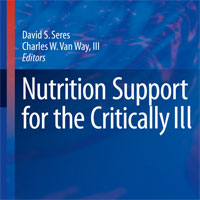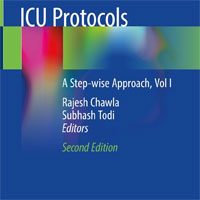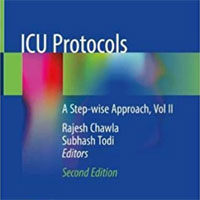Tag: nutrition
Safety and Efficacy of VBF in Critically Ill, Mechanically Ventilated Adults Using the PERFECT Protocol
Underfeeding in critical illness is common and associated with poor outcomes. According to large prospective hospital studies, volume-based feeding (VBF) safely and effectively improves energy and protein delivery to critically... read more
Continuous or Intermittent Feeding: Pros and Cons
Although there are limited studies investigating the safety and efficacy of an intermittent rather than continuous feeding regimen in critically ill adults, there are several theoretical advantages. Further studies should... read more
Long-term Health Consequences of Under- and Over-feeding in PICU
Energy is essential for the treatment and recovery of children admitted to Pediatric Intensive Care Units (PICU). There are significant immediate and long-term health consequences of both under- and over-feeding in this population.... read more
Ideas for Future Intensive Care
Progress toward determining the true worth of ongoing practices or value of recent innovations can be glacially slow when we insist on following the conventional stepwise scientific pathway. Moreover, a widely accepted but... read more
Pharmacotherapy in Neurointensive Care
Neurointensive care medicine has experienced great advancements and developments of neuromonitoring techniques, allowing a better comprehension of acute brain injury early phase pathological mechanisms and an overall improvement... read more
How to Deal with Severe Acute Pancreatitis in the Critically Ill
Management of severe acute pancreatitis (SAP) is multimodal with emphasis on monitoring, adequate fluid resuscitation, avoiding prophylactic use of antibiotics, cause-directed procedures or treatment, and organ support. There... read more
A Randomized Trial of Glutamine and Antioxidants in Critically Ill Patients
Critically ill patients have considerable oxidative stress. Glutamine and antioxidant supplementation may offer therapeutic benefit, although current data are conflicting. In this blinded 2-by-2 factorial trial, we randomly... read more
Expanding the Differential for Hypotension in the Pediatric Patient
As many ED practitioners are aware, food allergies are common in the first 2 years of life, with a prevalence cited between 1-10% of the population. Most food allergies are IgE-mediated hypersensitivity reactions. Food protein-induced... read more
Increased Hospital-Based Physical Rehabilitation and Information Provision After ICU Discharge
Post-ICU hospital-based rehabilitation, including increased physical and nutritional therapy plus information provision, did not improve physical recovery or HRQOL, but improved patient satisfaction with many aspects of recovery.... read more
Associations of Dietary Cholesterol or Egg Consumption With Incident Cardiovascular Disease and Mortality
Among US adults, higher consumption of dietary cholesterol or eggs was significantly associated with higher risk of incident cardiovascular disease (CVD) and all-cause mortality in a dose-response manner. 29,615 adults pooled... read more
Patient-important outcomes in randomized controlled trials in critically ill patients
Patient-important outcomes are rarely primary outcomes in RCTs in critically ill patients published in 2013. Among them, mortality accounted for the majority. We promote the use of patient-important outcomes in critical care... read more
Nutrition Support for the Critically Ill
This text provides a review of the current knowledge in both the mechanics of nourishing the critically ill and the metabolic and immunological roles nutrients play. In-depth chapters discuss disease-related malnutrition... read more

How to Improve Worldwide Early Enteral Nutrition Performance in ICUs?
Early enteral nutrition (EEN), typically started within 48 h after ICU admission, is recommended to be superior over delayed enteral nutrition and parenteral nutrition. The ESICM Working Group on Gastrointestinal Function... read more
Dosing Adjuvant Vitamin C in Critically Ill Patients Undergoing CRRT
We read with great interest the recent letter to Critical Care by Marik and Hooper. Vitamin C is increasingly recognized as a crucial compound to alleviate morbidity in critically ill patients. Vitamin C concentrations, however,... read more
Principles of Fluid Management and Stewardship in Septic Shock
There are only four major indications for fluid administration in the critically ill: resuscitation, maintenance, replacement and nutrition (enteral or parenteral). In this review, a conceptual framework is presented looking... read more
Nutrition in Surgery Podcast
Changing Care to Improve Surgical Outcomes. In this mini-series of six podcasts sponsored by Abbott Nutrition, the DCRI's Paul Wischmeyer, MD, EDIC, welcomes distinguished scientists and clinicians from the U.S. and the U.K.... read more
The Patient, The Whole Patient and Nothing But The Patient
In this short opinion piece, career and consumer advisor Belinda MacLeod-Smith challenges us to consider crucial elements of whole patient care, and how they can be impacted by limiting factors. Caring for someone with ongoing,... read more
Can probiotics be an alternative to chlorhexidine for oral care in the mechanically ventilated patient?
In this multicentre study, we could not demonstrate any difference between Lp299 and CHX used in oral care procedures regarding their impact on colonisation with emerging potentially pathogenic enteric bacteria in the oropharynx... read more
Exploring the Potential Effectiveness of Combining Optimal Nutrition With Electrical Stimulation to Maintain Muscle Health in Critical Illness
This article explores the potential role of nutrition and EMS in maintaining muscle health in critical illness. Within this article, we will evaluate fundamental concepts of muscle wasting and evaluate the effects of EMS,... read more
Never Underestimate the Simple Things We Do To Our Patients
In this compelling episode, Professor Paul Wischmeyer, shares some of his experiences as a patient in the ICU. Since he was 15 he has endured multiple hospitalizations and ICU stays for his inflammatory bowel disease. This... read more
Proton-Pump Inhibitor Prophylaxis in the ICU
Critical illness can disrupt local and systemic mechanisms that protect against upper gastrointestinal bleeding, a condition that may be associated with increased mortality, particularly among patients receiving extracorporeal... read more
Initial Trophic vs Full Enteral Feeding in Patients With Acute Lung Injury
In patients with acute lung injury, compared with full enteral feeding, a strategy of initial trophic enteral feeding for up to 6 days did not improve ventilator-free days, 60-day mortality, or infectious complications but... read more









